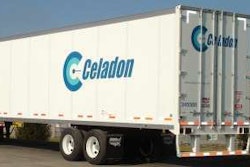Volvo Trucks on Thursday, Jan. 26, announced that it now will offer a 455 horsepower rating for the XE13 – exceptional efficiency – powertrain package. Volvo Trucks introduced the initial XE13 package with a 425 hp rating in September 2011. The new rating provides additional horsepower while still allowing the engine to cruise at 1,150 rpm at 65 mph.
“Our first introduction of the XE13 concept focused on exceptionally fuel-conscious fleets that spend considerable time cruising at highway speeds,” says Ron Huibers, Volvo Trucks president of North American sales and marketing, sai. “The new 455 horsepower rating is aimed toward the higher performance demands of longhaul fleets.”
Available on Volvo VN series tractors, the XE13 455 hp package is rated up to 80,000 pounds GCWR and includes the following components:
• Volvo D13 engine with 455 hp and 1,750 lb.-ft. of torque;
• Volvo I-Shift overdrive transmission with a 0.78:1 ratio;
• Axle ratios of 2.64 to 2.69; and
• Proprietary software that facilitates seamless communication between Volvo’s integrated powertrain components.
Through the XE13 package, Volvo Trucks lowers engine rpm at a given vehicle speed, a concept Volvo calls “downspeeding.”
“Integrated with our Volvo engines, the intelligence of the proprietary Volvo I-Shift automated mechanical transmission and software gives us great flexibility as we expand our downspeeding concept to offer improved fuel efficiency.” says Ed Saxman, Volvo Trucks product manager – powertrain.
According to Saxman, customer data shows that the XE13 package consistently operates in the engine’s ‘sweet spot” – 1,050 rpm to 1,500 rpm – with up to 70 percent of operation in the most efficient range of 1,100 rpm to 1,200 rpm. “Operating in this range yields about a 1.5 percent fuel efficiency improvement for every 100 rpm of downspeeding, so the XE13 package with the 455 horsepower rating will deliver about a 3 percent fuel efficiency gain,” he says.










